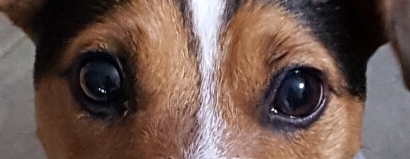 About 18 years ago I moved back to the US from overseas to find the world of dog training in a sort of renaissance. Instead of working to avoid correction (remember how dogs were literally yanked back to your leg when learning to heel?), training was now something that the dogs enjoyed and in which they eagerly participated as equal partners. There was a new focus on working for rewards, shaping and clicker training, making the dog operant, and incorporating games into training.
About 18 years ago I moved back to the US from overseas to find the world of dog training in a sort of renaissance. Instead of working to avoid correction (remember how dogs were literally yanked back to your leg when learning to heel?), training was now something that the dogs enjoyed and in which they eagerly participated as equal partners. There was a new focus on working for rewards, shaping and clicker training, making the dog operant, and incorporating games into training.
And there was the “watch me” command. You know, the command used to teach your dog to look you in the eyes and let everything else, all of the squirrels, other dogs, people, cars, etcetera, fade into the background. Nothing else exists as you and your dog are encapsulated in a bubble floating above the distractions. Obviously this is a great tool – your dog must be engaged with you before it can learn anything. For many trainers, it is the “go to” command for the leash reactive dog – the one that loses it when he sees other dogs or people, lunging, barking, and pulling. This particular application of the “watch me” command irritated me at first. I balked at it. I used it (and still do, but in a modified manner for these cases), but I didn’t fully believe in it. It didn’t work for every reactive dog. It took years before I could put my finger on why. I felt something was missing. And it was.
The theory is that the dog can’t be distracted by or respond to outside stimuli if his eyes are on you. That is not entirely true. Think back to your college days: Just as you could sit in a lecture appearing rapt, your eyes focused on the instructor, an approving grin on your face that would indicate your presence, your mind could be a million miles away, probably in the rathskeller. Merely having your dog look at you when faced with distractions doesn’t mean he is entirely present at the moment and it won’t teach your dog how to really handle his frustrations and insecurities. He can have his eyes on you, but every fiber of the rest of his body and mind is still focused elsewhere. His ears might still be pointed in the direction of the distraction and his entire body might even be leaning away from you. He can still be in a heightened state, a coiled spring ready to launch the instant you signal it’s okay for him to turn his gaze away. He’s obediently focusing his eyes on you, but still very concerned with the approaching dog, person, bicycle, or whatever the trigger may be. Think about a horse wearing blinders. Blinders are used to prevent the horse from being panicked or distracted by what is happing behind them. But they don’t guarantee the horse won’t bolt in panic when it hears something startling or if something the horse fears suddenly appears in front of him. The reactive dog needs to learn to become a passive observer of the world around him. Allow your dog to see the world, but teach him to remain connected to you, with more than just his eyes, teach him to control his impulses and move through the world with the confidence that you are walking with him and listening to him.